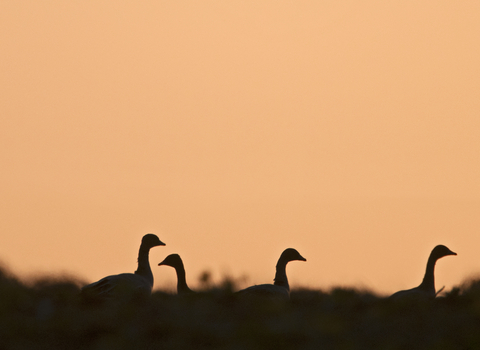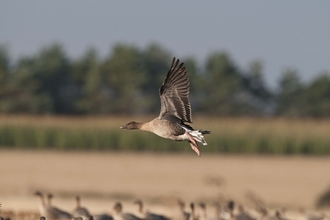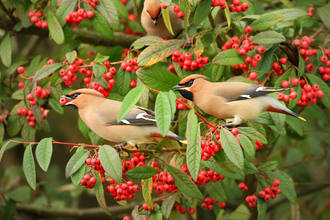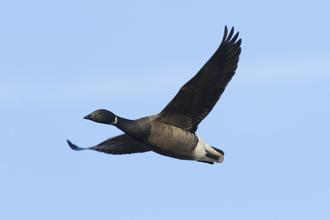Pink footed geese
Having spent the brief Arctic summer nesting in central Iceland, pink-footed geese take to open water and spend 25 days afloat, moulting their wing feathers before their flight south. One mid-autumn day, with the wind in the right direction, and temperature and food levels dropping, pink-footed families take off. Into the North Atlantic they fly, making landfall on the Faroe Islands six hours later, resting for a day before taking off again towards British shores. A day later, they land on our coasts. Over 400,000 pink-footed geese spend the winter in the UK.
The sight and sound of thousands of geese heading overhead, skein after skein, ‘ink ink’ing as they go is one of the highlights of the autumn wildlife calendar
Special spots
In October 2015 a record breaking 85,632 pink-footed geese were counted at Montrose Basin; one quarter of the UK's wintering population at the time. Minutes from the centre of Montrose, the tidal Montrose Basin in Angus plays host to one of the largest autumn gatherings of pink-footed geese in Scotland during October and November. Flocks roost overnight on the open water of the estuary, leaving the basin at dawn to fly out to feed on the surrounding fields, and moving on to other feeding grounds further south later in the year, in Lancashire and East Anglia.
- Lincolnshire, Gibraltar Point
- Norfolk, Holme Dunes
- Norfolk, Cley Marshes
- Northumberland, East Chevington
- Yorkshire, Spurn National Nature Reserve
- Yorkshire, North Cave Wetlands
- Yorkshire, Staveley Nature Reserve
How to do it
For the greatest spectacle, visit at dawn or dusk. Bring your binoculars, and a flask of hot chocolate, woollies and your best gloves are essential to keep you warm!
If you can't get to these places
Pink-footed geese move about a lot during the winter, with flocks flying from Scotland to Lancashire to Norfolk and back in a few days. Keep your eyes skywards, as a skein of high flying geese could well be pink-feet.
More wildlife experiences
From seeing colourful wildflowers to spotting magnificent birds of prey, we can help you get closer to wildlife across the UK.








